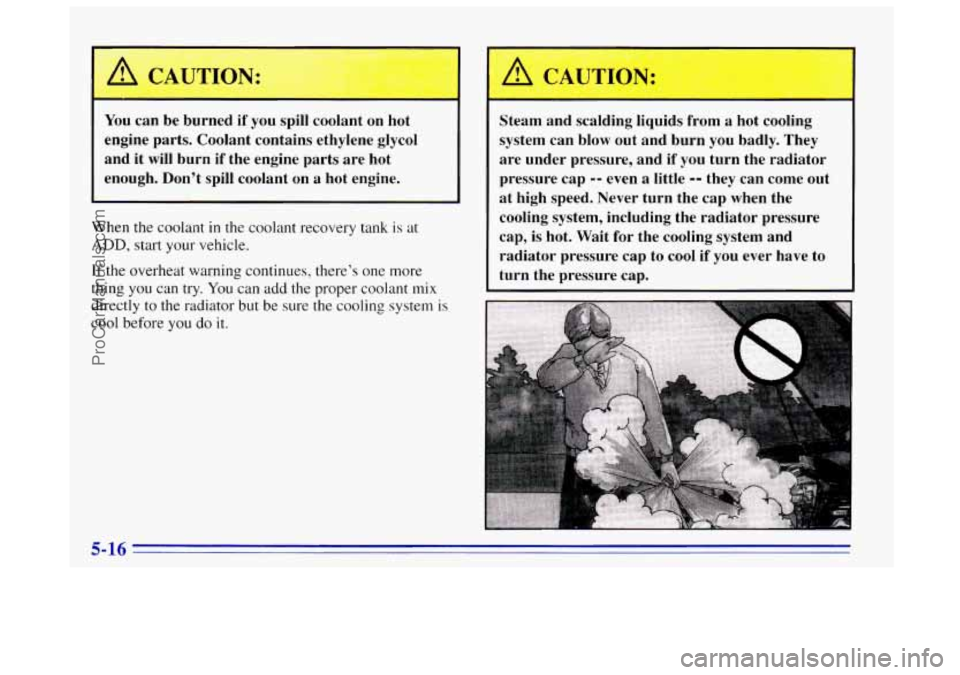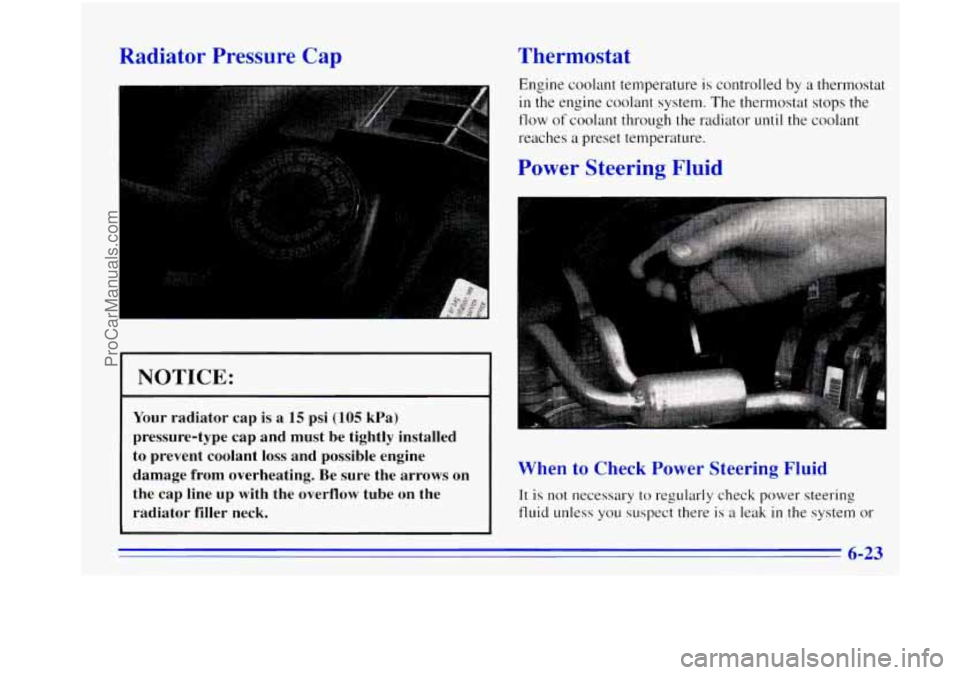engine overheat OLDSMOBILE BRAVADA 1996 User Guide
[x] Cancel search | Manufacturer: OLDSMOBILE, Model Year: 1996, Model line: BRAVADA, Model: OLDSMOBILE BRAVADA 1996Pages: 340, PDF Size: 17.49 MB
Page 196 of 340

You can be burned if you spill coolant on hot
engine parts. Coolant contains ethylene glycol
and
it will burn if the engine parts are hot
enough. Don't spill coolant on
a hot engine.
When the coolant
in the coolant recovery tank is at
ADD, start your vehicle.
If the overheat warning continues, there's one more
thing you can try. You can add the proper coolant
mix
directly to the radiator but be sure the cooling system is
cool before you do it.
Steam and scalding liquids from a hot cooling
system can blow out and burn you badly. They
are under pressure, and if you turn the radiator
pressure cap
-- even a little -- they can come out
at high speed. Never turn the cap when the
cooling system, including the radiator pressure
cap, is hot. Wait for the cooling system and
radiator pressure cap to cool if you ever have to
turn the pressure cap.
ProCarManuals.com
Page 209 of 340

Return the jack, wheel wrench and wheel blocks to the
proper location
in your vehicle’s rear area. Secure the
items and replace the
jack cover.
L
A. Retainer E Wheel Blocks
B. Rubber Band G. Hub Cap
(Some Models) Removal
Tool
C.
Work Gloves H. Wheel Wrench
D. Mat I. Jack
E. Jack Storage Cover J. Jacking Instructions
If You’re Stuck: In Sand, Mud,
Ice or Snow
r vehicle is stuck is What you don’t want to do wne
to spin your wheels too fast. The method known as
“rocking” can help you get out when you’re stuck, but
you must use caution.
If you let your tires spin at high speed, they can
explode, and you or others could be injured.
And, the transmission or other parts
of the
vehicle can overheat. That could cause an engine
compartment fire or other damage. When you’re stuck, spin the wheels as little as possible. Don’t
spin the wheels above 35 mph
(55 kmh) as shown
on the speedometer.
ProCarManuals.com
Page 231 of 340

Rear Axle What to Use
When to Check and Change Lubricant
Refer to the Maintenance Schedule to determine how
often to check the lubricant and when to change it. See
“Scheduled Maintenance Services”
in the Index.
How to Check Lubricant
If the level is below the bottom of the filler plug hole,
you’ll need to add some lubricant. Add enough lubricant
to raise the level
to the bottom of the filler plug hole. Refer to the Maintenance
Schedule to determine what
kind of lubricant to use. See “Recommended Fluids and
Lubricants”
in the Index.
Engine Coolant
The cooling system in your vehicle is filled with new
DEX-COOL TM (orange-colored, silicate-free) engine
coolant. This coolant
is designed to remain in your
vehicle for
S years or 100,000 miles (1 66 000 km),
whichever occurs first.
The following explains your cooling system and
how to
add coolant when it is low. If you have a problem with
engine overheating, see “Engine Overheating”
in
the Index.
A SO/SO mixture of water and the proper coolant for
your Oldsmobile
will:
0 Give freezing protection down to -34°F (-37°C).
0 Give boiling protection up to 265°F (129°C).
0 Protect against rust and corrosion.
Help keep the proper engine temperature.
Let the warning lights and gages work as
they should.
ProCarManuals.com
Page 232 of 340

NOTICE:
When adding coolant it is important that you use
DEX-COOL
TM (orange-colored, silicate-free)
coolant meeting
GM Specification 6277M.
If silicated coolant is added to the system,
premature engine, heater core or radiator
corrosion may result.
In addition, the engine
coolant will require change sooner
-- at
30,000 miles (50 000 km) or 24 months,
whichever occurs first.
What
to Use
Use a mixture of one-half
clean water (preferably
distilled) and one-half
DEX-COOL TM (orange-colored,
silicate-free) antifreeze that meets
GM Specification
6277M, which won’t damage aluminum parts. Use
GM Engine Coolant Supplement (sealer) (GM Part
No. 3634621) with any complete coolant change. If you
use this mixture, you don’t need to add anything else.
A CAUl ,ON:
Adding only plain water to your cooling system
can be dangerous. Plain water,
or some other
liquid like alcohol, can boil before the proper
coolant mix will. Your vehicle’s coolant warning
system is set for the proper coolant mix. With
plain water or the wrong mix, your engine could get too hot but you wouldn’t get the overheat
warning. Your engine could catch fire and you
or
others could be burned. Use a 50/50 mix of clean
water and DEX-COOL
TM (orange-colored,
silicate-free) antifreeze.
ProCarManuals.com
Page 233 of 340

NOTICE:
If you use an improper coolant mix, your engine
could overheat and be badly damaged. The repair
cost wouldn’t be covered by your warranty. Too
much water in the mix can freeze and crack the
engine, radiator, heater core and other parts.
If you have to add coolant more than four times a year,
have
your retailer check your cooling system.
NOTICE:
If you use the proper coolant, you don’t have to
add extra inhibitors or additives which claim to
imnrove the system. These can be harmful.
Checking Coolant
When your engine is cold, the coolant level should be at
ADD, or a little higher. When your engine is warm, the
level should be
up to FULL HOT, or a little higher.
ProCarManuals.com
Page 235 of 340

Radiator Pressure Cap
I
NOTICE:
Your radiator cap is a 15 psi (105 kPa)
pressure-type cap and must be tightly installed
to prevent coolant loss and possible engine
damage from overheating. Be sure the arrows on
the cap line up with the overflow tube on the
radiator filler neck.
Thermostat
Engine coolant temperature is controlled by a thermostat
in the engine coolant system. The thermostat stops the
flow of coolant through the radiator
until the coolant
reaches a preset temperature.
Power Steering Fluid
When to Check Power Steering Fluid
It is not necessary to regularly check power steering
fluid unless you suspect there is a leak in the system or
6-23
ProCarManuals.com
Page 335 of 340

Ordering Publications ............................ 8-9
Outside Mirrors
................................ 2-34
Overdrive. Automatic Transmission
................ 2- 16
Overhead Console .............................. 2-35
Overheating Engine
............................. 5- 1 1
Owner Checks and Services ....................... 7-39
Paint Spotting. Chemical
........................ 6-50
Park
......................................... 2-14
Shifting Into
................................. 2- 18
Shifting Out
of ............................... 2-20
AtNight
..................................... 2-9
Brake
...................................... 2-17
Brake Mechanism Check
....................... 7-42
On Hills with
a Trailer ......................... 4-50
Over Things That Burn
........................ 2-20
Passing
....................................... 4-11
Payload
....................................... 4-43
Periodic Maintenance Inspections
.................. 7-43
Power
Accessory Outlet
............................. 2-43
Remote Control Mirror
........................ 2-34
Steering Fluid
................................ 6-23
Windows
................................... 2-22
Parking
Lots
........................................ 2-9
DoorLocks
................................... 2-4
Steering
..................................... 4-8 PowerSeat
..................................... 1-1
Pregnancy.
Use of Safety Belts .................... 1-22
Problems on the Road
............................
Radiator. Adding Coolant ....................... 5-17
Radiator Pressure Cap ........................... 6-23
Radio Reception
................................ 3-13
Radios
........................................ 3-6
Rain. Driving
.................................. 4-29
Rear
Axle
....................................... 6-19
Door Security Locks
........................... 2-4
Safety Belt Comfort Guides
..................... 1-26
Seatpassengers
.............................. 1-23
Seats
........................................ 1-4
Towing
..................................... 5-10
Window Defogger
............................. 3-5
Window WasherIWiper
........................ 2-27
Rearview Mirror
................................ 2-33
Reclining Front Seatbacks
......................... 1-2
Recommended Fluids and Lubricants
.......... 6-58. 7-45
Recovery Hooks
................................ 5-30
Recovery Tank. Coolant
.......................... 5-13
Replacement Bulbs
...................................... 6-56
Parts ....................................... 6-57
Wheel
...................................... 6-42
Reporting Safety Defects
.......................... 8-7
9-7
ProCarManuals.com